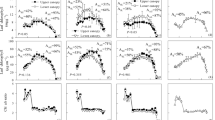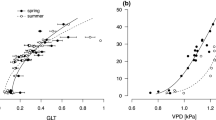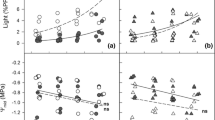Abstract
To examine the predictability of leaf physiology and biochemistry from light gradients within canopies, we measured photosynthetic light-response curves, leaf mass per area (LMA) and concentrations of nitrogen, phosphorus and chlorophyll at 15–20 positions within canopies of three conifer species with increasing shade tolerance, ponderosa pine [Pinus ponderosa (Laws.)], Douglas fir [Pseudotsuga menziesii (Mirb.) Franco], and western hemlock [Tsuga heterophylla (Raf.) Sarg.]. Adjacent to each sampling position, we continuously monitored photosynthetically active photon flux density (PPFD) over a 5-week period using quantum sensors. From these measurements we calculated FPAR: integrated PPFD at each sampling point as a fraction of full sun. From the shadiest to the brightest canopy positions, LMA increased by about 50% in ponderosa pine and 100% in western hemlock; Douglas fir was intermediate. Canopy-average LMA increased with decreasing shade tolerance. Most foliage properties showed more variability within and between canopies when expressed on a leaf area basis than on a leaf mass basis, although the reverse was true for chlorophyll. Where foliage biochemistry or physiology was correlated with FPAR, the relationships were non-linear, tending to reach a plateau at about 50% of full sunlight. Slopes of response functions relating physiology and biochemistry to ln(FPAR) were not significantly different among species except for the light compensation point, which did not vary in response to light in ponderosa pine, but did in the other two species. We used the physiological measurements for Douglas fir in a model to simulate canopy photosynthetic potential (daily net carbon gain limited only by PPFD) and tested the hypothesis that allocation of carbon and nitrogen is optimized relative to PPFD gradients. Simulated photosynthetic potential for the whole canopy was slightly higher (<10%) using the measured allocation of C and N within the canopy compared with no stratification (i.e., all foliage identical). However, there was no evidence that the actual allocation pattern was optimized on the basis of PPFD gradients alone; simulated net carbon assimilation increased still further when even more N and C were allocated to high-light environments at the canopy top.
Similar content being viewed by others
Author information
Authors and Affiliations
Additional information
Received: 12 August 1998 / Accepted: 25 March 1999
Rights and permissions
About this article
Cite this article
Bond, B., Farnsworth, B., Coulombe, R. et al. Foliage physiology and biochemistry in response to light gradients in conifers with varying shade tolerance. Oecologia 120, 183–192 (1999). https://doi.org/10.1007/s004420050847
Issue Date:
DOI: https://doi.org/10.1007/s004420050847




